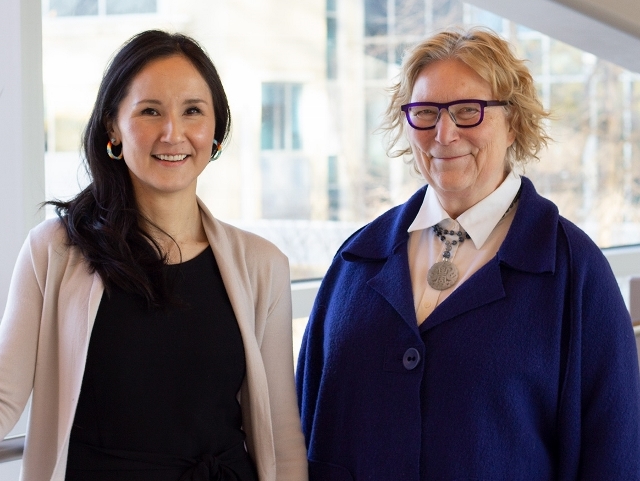
Tibetha Kemble, Director of Indigenous Health, and Jill Konkin, Associate Dean of Community Engagement, were recognized with U of A's 2019 Equity, Diversity and Inclusion Award.
A historical change was made to the Faculty of Medicine & Dentistry's (FoMD) admissions process for Indigenous students in November 2018, thanks to the leadership of Jill Konkin and Tibetha Kemble, winners of the U of A's 2019 Equity, Diversity and Inclusion award.
For thirty years, the FoMD reserved five positions for Indigenous students admitted to the MD program through the Indigenous Health Initiatives Program (IHIP) process per year. While this was once intended to encourage Indigenous enrollment, an ever-increasing number of Indigenous applicants has made this upper limit delimiting in working to close the gap in the number of Indigenous medical professionals.
For the fall of 2019 application cycle, the upper limit will be lifted and all Indigenous students who qualify will be offered a place in the medical school in 2020, opening doors for prospective Indigenous students who will in turn join other Indigenous voices in the medical community who can speak to the needs of their communities.
Collaboration for a broader definition of excellence
Kemble, director of Indigenous Health and Konkin, Associate Dean of Community Engagement, are both quick to praise each other for their individual contributions to driving the change.
"Dr. Konkin was courageous in her leadership," Kemble said. "Early on in my role, the conversation about removing the upper limit on Indigenous admissions wasn't on the table. It was more focused on working with what we have in order to influence the system. When Dr. Konkin asked the question 'why do we have a limit at all?' everything seemed to open up," she said.
"That helped to inform and shape how substantive equality was used as a foreground to advance this proposal through University governance. I think our work together demonstrates how people within a system can work together to advance the needs of Indigenous peoples in meaningful ways."
When Kemble took on the role of director in 2017, she recognized the need for coordination of Indigenous Health activities and to create a strategic direction forward. The first step was to develop and introduce a strategic plan that focused on five key pillars: Indigenous Health Professionals, Spaces and Places, Relationships, Commitments & Partnerships, and Learning & Development. According to Kemble, the larger goal of the strategic plan was to focus on key initiatives that would create and enable system-level change and a more inclusive culture within the FoMD for Indigenous students, faculty, and staff.
"We would never have gotten there without the kind of work that Tibetha has been doing," said Konkin. "What was exciting to me about this process was that it was clear that we changed some people's minds."
Since the proposal to remove the upper limit on Indigenous admissions wasapproved by General Faculties Council in November 2018, a review of Indigenous Admissions facilitated by Marie Delorme, a prominent organizational consultant and 2019 Order of Canada inductee, took place in March 2019 with the goal of ensuring that internal policies and processes supported the implementation of TRC Call to Action 24 in meaningful ways.
"The Indigenous Admissions Review provides direction on the specific actions that are necessary in order to better facilitate Indigenous admissions," Kemble said. "It's important to understand that we've got to do some behind the scenes work so that policies and processes aren't limiting student entry and success."
"If the barriers didn't exist, we wouldn't need to have these conversations," Konkin added. "People would be moving in and out of places where everybody would be welcomed into all of these spaces. But what we're asking people to do is to question their own power and privilege, and to be thoughtful about their own role in reconciliation. Because there is unfortunately an assumption that there aren't Indigenous people who are brilliant who are going to be the best doctors ever, and this is a step towards correcting that."